The Mexican fare, a marriage of Mesoamerican cooking techniques/main staples and European food components (such as cheese and meat and herbs), is one of the most complex my taste buds have ever encountered. It's up there with Persian, Indian and Chinese. The ingredients of dishes, I could not easily detect. And a lot of them I didn't/don't even know of.
Case in a point: Papaloquelite and huauzontle and huitlacoche (fungus that grows on corn). IKR?!
The function of food for Mexicans is not only to fuel the body. It plays a role in traditions and festivals (such as Día de Muertos), and everyday social gatherings. The preparation itself, which mostly takes hours, draws people together.
To pay homage to this intangible cultural heritage (and to food technology), I the pilgrim, sampled all sorts of Mexican food for a week in Cancun. Plus uhm, two days in Palenque. I can see the aftermath on my significantly wider waistline now, but that's a non-significant issue I shall deal with later.
Here are some of the delights I stuffed myself with:
1. Tacos. The most popular Mexican dish — outside Mexico, I daresay. Wheat or corn (I prefer the latter) tortilla, topped/filled with different kinds of meat (beef, chicken, pork, seafood) plus cheese and veggies. Always accompanied by either guacamole or salsa or pickled onions. I like mine with salsa verde, a kind of salsa made with tomatillos. There's a plethora of traditional varieties in every Mexican state, dictated by the region's main spices and produce.

2. Pollo En Mole Poblano. Mole, from Nahuatl (Aztec language) word mōlli, means 'sauce'. Such term is used for a variety of sauces. The states of Puebla and Oaxaca (Tlaxcala too) claim to be the origin of it. Mole poblano, my fave, is a kind of mole that's composed of a million ingredients — okay, maybe about twenty (including ancho chili or poblano and chipotle and sometimes chocolate) — pound together to form a paste. Added with water and simmered in a pot, it results to a thick, dark-colored sauce. This sauce is poured over turkey or chicken. Had the best in Puebla.
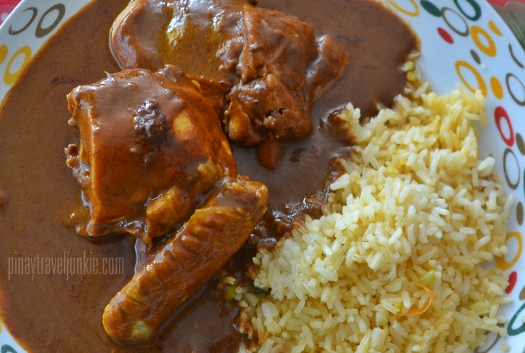
55 MXN, ordered twice in a week at Mercado 28.
3. Filete De Pescado Empanizado. Ordered at a time when my palate had a craving for subtle flavors. Breaded fish fillet with refried beans (refried means well fried, not 'fried again'), arroz (rice), beans and salad. Not really traditional, but like the milanesa (breaded beef, chicken or pork), it's a pretty popular comida. Especially to niños y niñas.

4. Carne Asada De Cerdo. Grilled thinly sliced, marinated meat (usually beef). This one's pork, marinated with salt and lime. Sometimes carne asada is served as the main dish. Sometimes chopped to be used as filling for tacos and quesadillas and other antojitos (snacks).
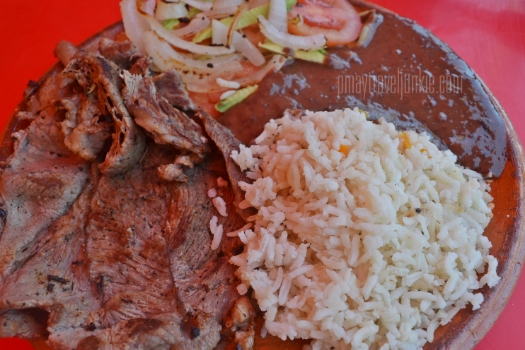
Also one of the comidas fijas at Cochipavos, Mercado 28. 60 MXN.
5. Nachos. Created by restaurateur Ignacio "Nacho" Anaya, circa 1943. The story goes that Anaya whipped up the meal with the few ingredients he had left in his kitchen for a group of wives of U.S. soldiers who arrived at his restaurant after it had closed. He cut tortillas into smaller pieces, added shredded cheese then heated them. Before serving he tossed in pickled jalapeños. Anaya's son, Ignacio Anaya Jr., stated that the person who named it 'Nachos Especiales' was Mamie Finan, after the snack was served to her and her friends.
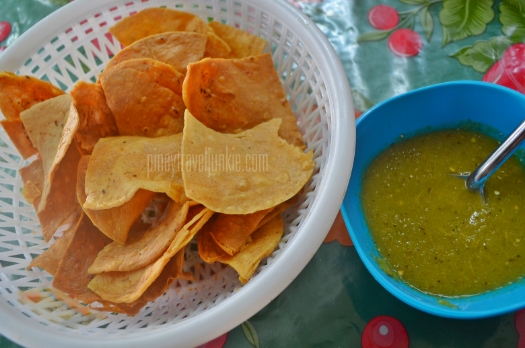
6. Huevos Rancheros. Popular Mexican desayuno (breakfast) of fried eggs on fried tortillas topped with tomato and chili sauce. Served with beans and sometimes rice.
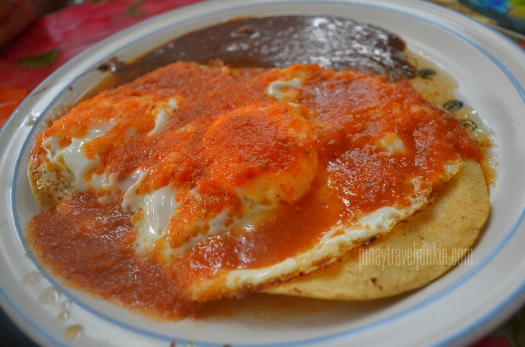
7. Huevos Motuleños. Another desayuno meal which originated in Motul City, Yucatan. Like the huevos rancheros, it's made of fried eggs on tortilla with tomato sauce. But also with other ingredients like ham and fried plantain (and sometimes cheese).
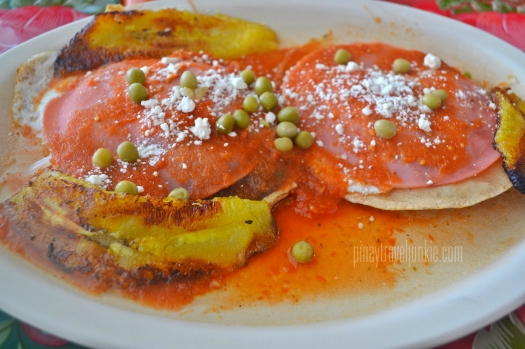
8. Pancita. Also called menudo (the Philippines has a tomato-based stew of the same name but is made of pork and liver). Tripe in a light, chili-based soup. Not spicy. Cooked for hours! Chopped cilantro, onions, and a squeeze of lime are added upon serving. Eaten with tortilla.

9. Gordita. My new fave antojito! Thick tortilla made with corn flour (dough resembles that of the Philippine empanada's), fried or baked, stuffed with meat and cheese and vegetables.
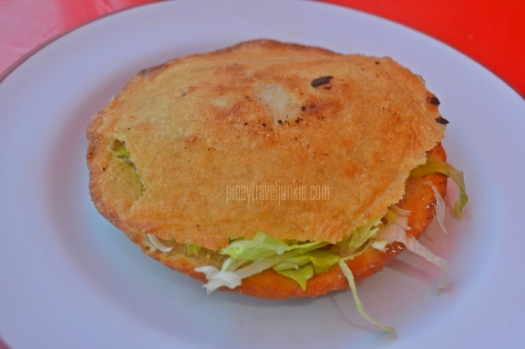
10. Carne Al Pastor (sheperd-style), Res (beef). Spit-grilled/roasted meat, thinly sliced, then served with rice. Or used as fillings for a variety of antojitos. Meat is marinated with various spices and chiles and pineapple. This al pastor meal I had even got pineapple bits.
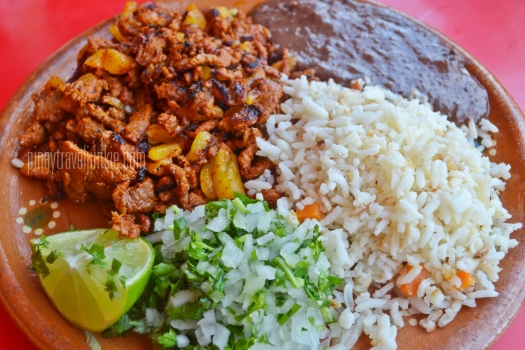
11. Cochinita Pibil. Cochinita means baby pig and pibil means buried. Suckling pig, roasted in a fire pit. These days, other pork cuts are used as alternative. Meat is marinated in citrus juice before it is slow-roasted (wrapped in banana leaf). Achiote (atsuete in the Philippines) gives it a reddish hue.

Served with rice, refried beans and pickled onions. 60 MXN.
12. Torta. A Mexican sandwich that uses an oblong white bread/roll and is filled with meat, cheese, caramelized onions and peppers. I like mine with grilled/toasted bread, al pastor, Oaxaca cheese and cebolla asada (roasted onion).
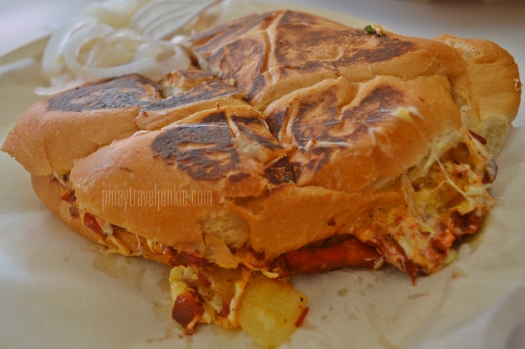
27 MXN at the perpetually busy Tropi Tacos, Palenque.
13. Sope. An antojito of fried masa (thick, round-shaped, pinched on the sides) topped with meat, beans, veggies and cheese. This one I had is more like a huareche. A variation of the sope which is oblong in shape. Similar to the shape of a Mexican sandal of the same name.
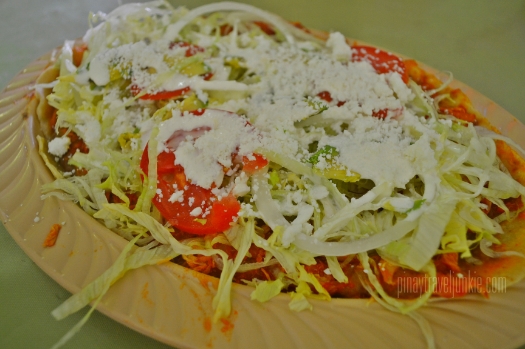
14. Quesadilla. Here's another familiar antojito. The word is a portmanteau of queso (cheese) and tortilla. Corn or flour tortilla, filled not only with cheese but also meat and veggies. Folded in half.
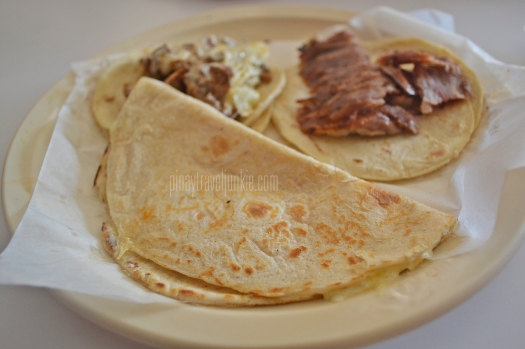
15. Because uhm, cerveza is food.
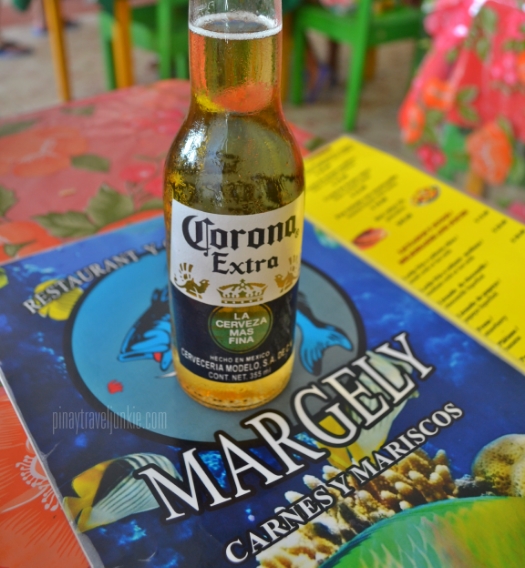
I remember being asked by Pop Talk host Kuya Tonipet Gaba in the show's third anniversary special (while doing a review of some new Mexican resto in Boracay) if I can eat Mexican food every day. My answer was a quick 'yes'. And I reckon this list is a dang good explanation.
ShareTweet
This page was viewed times.



















2 comments:
August 5, 2014 at 8:08 AM
finally you feature something/place that i've been (mercado 28). unlike you i had a bad experience with food there.
August 5, 2014 at 8:40 AM
Aww, that's unfortunate :( We ate there almost the entire week and never had any bad experience.
Post a Comment